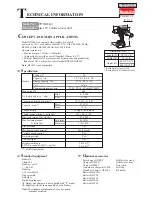
2. Turn the torque and operating mode setting ring
to the desired torque value.
7.6.3 Removing the bit / bit holder
1. Set the forward / reverse switch to the middle
position or remove the battery from the power
tool.
2. Remove the bit from the bit holder.
3. Remove the bit holder from the chuck.
8. Care and maintenance
CAUTION
Before beginning cleaning, remove the battery from
the power tool in order to prevent unintentional
starting.
8.1 Care of insert tools
Clean off dirt and dust deposits adhering to the insert
tools and protect them from corrosion by wiping the
insert tools from time to time with an oil-soaked rag.
8.2 Care of the power tool
CAUTION
Keep the power tool, especially its grip surfaces,
clean and free from oil and grease. Do not use
cleaning agents which contain silicone.
The outer casing of the power tool is made from
impact-resistant plastic. Sections of the grip are made
from a synthetic rubber material.
Never operate the power tool when the ventilation
slots are blocked. Clean the ventilation slots carefully
using a dry brush. Do not permit foreign objects to
enter the interior of the power tool. Clean the outside
of the power tool at regular intervals with a slightly
damp cloth. Do not use a spray, steam pressure
cleaning equipment or running water for cleaning.
This may negatively affect the electrical safety of the
power tool.
8.3 Maintenance
WARNING
Repairs to the electrical section of the power tool
may be carried out only by trained electrical spe-
cialists.
Check all external parts of the power tool for damage
at regular intervals and check that all controls operate
faultlessly. Do not operate the power tool if parts
are damaged or when the controls do not function
faultlessly. If necessary, the power tool should be
repaired by Hilti Service.
8.4 Care of the battery
Keep the electrical contacts free from dust, oil and
grease. If necessary, use a clean cloth to clean the
contact surfaces. Do not continue to operate the
power tool until the battery is completely discharged
as this may damage the battery cells. Recharge the
battery as soon as a drop in performance is noticed.
The battery should be given a conditioning charge
at monthly intervals or, at the latest, when battery
capacity drops significantly. With the Hilti C 7/24,
SFC 7/18, SFC 7/18H and TCU 7/36 chargers, this is
done by charging the battery for 24 hours in normal
mode or for 12 hours in conditioning mode. The Hilti
C 7/36-ACS charger determines automatically when
an initial charge or conditioning charge is necessary.
If battery capacity is still unsatisfactory after the
conditioning charge, we recommend that the battery
is returned to Hilti for diagnosis.
8.5 Checking the power tool after care and
maintenance
After carrying out care and maintenance work on
the power tool, check that all protective and safety
devices are fitted and that they function faultlessly.
e
n
24
Printed: 07.07.2013 | Doc-Nr: PUB / 5070659 / 000 / 00
Summary of Contents for SF151-A
Page 2: ...1 2 3 4 5 6 7 8 9 1 Printed 07 07 2013 Doc Nr PUB 5070659 000 00 ...
Page 3: ...1 2 1 R L STOP 1 3 2 1 1 2 3 3 2 1 2 3 4 5 6 Printed 07 07 2013 Doc Nr PUB 5070659 000 00 ...
Page 17: ...de 14 Printed 07 07 2013 Doc Nr PUB 5070659 000 00 ...
Page 31: ...en 28 Printed 07 07 2013 Doc Nr PUB 5070659 000 00 ...
Page 87: ...nl 84 Printed 07 07 2013 Doc Nr PUB 5070659 000 00 ...
Page 101: ...da 98 Printed 07 07 2013 Doc Nr PUB 5070659 000 00 ...
Page 139: ...fi 136 Printed 07 07 2013 Doc Nr PUB 5070659 000 00 ...
Page 153: ...pt 150 Printed 07 07 2013 Doc Nr PUB 5070659 000 00 ...
Page 167: ...el 164 Printed 07 07 2013 Doc Nr PUB 5070659 000 00 ...
Page 209: ...lt 206 Printed 07 07 2013 Doc Nr PUB 5070659 000 00 ...
















































